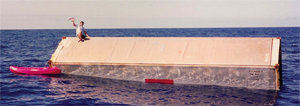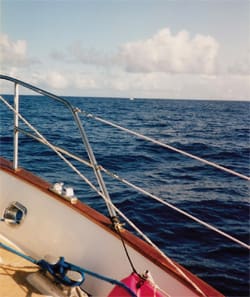Colliding with a water-logged shipping container in the middle of a gale is a sailor’s worst nightmare, but that’s exactly what happened to Capt. Andrew Segal one November evening while sailing his Pearson 530 from Newport to Bermuda.
It was around 2200. Seas were running eight to 12 feet and winds were blowing at 44 knots while Segal guided his 53-foot ketch through the storm.
“We were sailing hard to weather with a deeply reefed main and Yankee jib,” Segal recalled. “As we came back from heeling, the boat hit a container with such force it…almost threw me overboard.”
 |
 |
 |
 |
|
Not all containers float like this one, a refrigerator unit buoyant due to its insulated foam interior. |
Segal was lucky. His boat struck the container with a glancing blow. Nevertheless, he most likely hit a container weighing close to 60,000 pounds, virtually the same weight as his sailboat, and only a third shorter. Though his Pearson’s fiberglass hull was damaged, it remained intact enabling Segal to sail on.
Approximately 160 million containers cross the oceans each year. More than 99 percent complete their journey without incident. But accidents do occur. Severe weather sometimes sweeps inadequately lashed containers overboard, or an overloaded box atop a stack of six containers ends up in the sea.
According to the National Cargo Bureau, a marine surveying organization, no one keeps comprehensive statistics on the number of containers lost overboard. Why?
“Container operators don’t necessarily want to report that their containers go overboard,” said Bruce Lambert of the Institute for Trade and Transportation.
Ship companies prefer not to disclose how many containers they lose because it reflects poorly on their business. Maritime insurance companies also keep quiet preferring not to embarrass their clients.
The actual number of lost containers is miniscule compared to the number transported by sea each year. And since containers are insured there is little economic incentive to reduce their loss. That doesn’t make it any less hazardous for blue water sailors though, even if colliding with a lost shipping container is something of a “black swan” event.
Thousands of containers lost?
Ten thousand containers lost overboard per year is a widely cited figure, it also turns out to be unsubstantiated. In fact, the Through Transport Club, which insures 15 of the top 20 container lines, estimates the total number of containers lost at sea as less than 2,000 per year. That’s only 0.005 percent of the total number of containers traveling by ship in any given year.
The World Shipping Council (WSC), whose members represent 90 percent of the world’s containership capacity, conducted a survey among its members in August 2011. The survey reported that approximately 350 containers are lost at sea per year excluding catastrophic events (defined as 50 or more containers lost in a single incident). When catastrophic events are included, the yearly average climbs to 675. Still, that’s only a small fraction of the containers shipped by sea.
Perhaps the best documented incident of a collision with a container happened on Jan. 11, 2000. Marine investigators believe the British scallop trawler, Solway Harvester, struck a fully-loaded container in the Irish Sea killing all seven crewmembers. When rescuers arrived on the scene, plastic vats filled with mayonnaise were found floating near where the trawler went down.
But the worst incident in the history of container shipping occurred in 1998 when APL China lost 406 containers in the north Pacific. The ship somehow managed to survive 70-foot waves stirred up by Typhoon Babs though photographs suggest just barely. Three other containerships also fell victim, resulting in more than 1,000 containers lost overboard. And these were just the ones we know about.
“There are hundreds of ships losing random containers on a continuing basis,” said Michael McDaniel, editor of The Cargo Letter. In fact, contents from containers nobody knew were lost wash up on shore all the time. In 2006, a beach on North Carolina’s Outer Banks was blanketed with Doritos bags, many of them unopened. Richard Laporte even remembers running over a container while working on a 2,000-ton icebreaker.
“These things kept popping up,” Laporte said, referring to containers which had fallen off a ship they were assisting. “We split one open after hitting it head on at 12 knots. It was full of Cheez Whiz.”
Indeed, Donovan Hohn recently wrote an amusing book, Moby-Duck, about tracking a container full of rubber ducky bath toys washed overboard from Evergreen Ever Laurel in 1992. The ducks drifted all over the world and are still being found.
 |
A 40-foot container tends to lose structural integrity with 30 tons of cargo rolling around inside, but just how quickly it sinks depends on the cargo itself. A container filled with electronic components wrapped in Styrofoam floats longer than cargo that is easily waterlogged. And refrigerated boxes called reefers are inherently buoyant as are tank containers. They tend not to sink for a long, long time.
Floating for weeks?
According to Vero Marine, a 20-foot container can float for up to 57 days while a 40-foot container will float more than three times as long. That’s plenty enough time to collide with something, especially since a fully-loaded container will generally float only 18 inches above water. Additionally, they don’t always show up on radar and can be especially hard to spot at night as Segal and other sailors have experienced.
Ship owners disagree.
Mike Zampa, vice president of corporate affairs for American President Lines (APL), which owned the infamous APL China, said, “While it’s a concern for all carriers, the number (of containers lost overboard) for us is miniscule to zero.”
Dole’s head of operations expressed a similar sentiment. He told Ocean Navigator, “In 25 years with the company, I cannot remember one of our containers being lost overboard.”
Even the U.S. Coast Guard considers lost containers a negligible problem.
Unfortunately, these sentiments are cold comfort to sailors like Paul Lutus, who was jarred awake in the Indian Ocean one night while solo sailing around world.
“My boat lurched in a way I had never seen before,” Lutus recalled. “I went topside with a flashlight and saw a large, rectangular, object floating just at water level. It was massive…much bigger than my boat. I later realized it was a waterlogged container.”
Lutus was sailing Mariah, a Pacific Seacraft double ender at the time. Thirty-one feet long with a shoal keel, she was a sturdy boat with a three-inch-thick fiberglass hull below the waterline. As a result, its hull remained watertight. But had he struck one of the container’s four sharp corners, he might not have been so fortunate.
No real monitoring
Since the percentage of containers lost overboard is small compared to the total shipped by sea, not much is being done to minimize the problem. Monitoring systems such as transponders are too expensive except for the most dangerous of cargoes, and there’s little economic incentive for ship or cargo owners to spend money in an economic climate as dire as today. Nevertheless, some steps are being taken.
“While the actual number of containers lost at sea is dramatically less than most public statements indicate, the industry’s goal is to reduce those losses to as close to zero as possible,” said Anne Marie Kappel, vice president of WSC.
The Maritime Research Institute Netherlands is working on one such project. Called Lashings@Sea the initiative is designed to prevent container-lashing systems from failing. Given that humongous containerships carrying 15,000 metal boxes apiece already ply the ocean, and even bigger ones are on the way, this is probably a good idea.
But tell that to Helen McAdory, whose close encounter with six floating containers while sailing from Cape Town to Rio de Janeiro, is still clear in her mind many years later.
“I dodged through them by the skin of my teeth,” she recalled. “It wasn’t my happiest moment at sea.”
————–
John J. Geoghegan’s non-fiction book, Operation Storm, about a squadron of top secret underwater aircraft carriers purpose-built by Japan to launch a surprise attack against New York City and Washington, D.C., has just been published.

